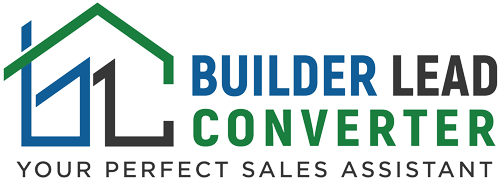In our third installment of, What’s the Best Way to Get Paid for Providing an Estimate, we conclude with some tips on streamlining the time it takes to prepare an estimate.
In this episode we discuss time goals from estimating a kitchen to a custom home, the use of templates to cut down on time and integrating finish levels into your estimating.
Read/Watch/Listen and dive into part three below.
Builder Lead Converter captures & converts leads for home builders & remodelers so they can grow sales revenue and margins. Find out how at https://www.builderleadconverter.com
Transcript:
Today in Conversations at Convert, we’ll be talking about part three. Of what’s the best way to get paid for providing an estimate? Let’s go ahead and get started.
Welcome to Conversations That Convert. Every week we’ll spend about 10 to 15 minutes tackling relevant lead generation marketing and sales topics for remodel. Home improvement companies and home builders conversations. That Convert is brought to you by Builder, lead Converter, your perfect sales assistant.
And now here’s Rick and Diana. Hello everyone. Welcome to Conversations That Convert. Hello, Diana. You look lovely
today. Thank you. Thank you and welcome everybody.
So what are we talking about today?
Today is part three of our series B, what a builder can ask, what’s the best way to get paid for providing an estimate?
So it seems that we can get paid for providing an estimate. And this is part free .
Exactly. We, we, we focused on part one and two, the previous two, two episodes. We’ll do a quick recap. It’s all part of our series where builders ask What is the best way to, and this is part of a program I will be presenting at the International Builders Show here next week in Las Vegas called Bidding Custom Homes and Remodeling Jobs, turning Estimates into a revenue stream.
And that is based on a case study from one of our clients who last year made almost $60,000 in what he calls pre-construction fees or an average of $4,500 per job. And that did not. Anything that was refundable, did not go to the job, was not design fees. That was purely money he charged to put together estimates, and he averages a 60% markup for remodeling and 30% for custom homes.
So it’s really, really a neat process. We’ve walked you through it. If you attend the Programming International Builders Show, we’re gonna get into a lot more details. We’ll have some more time. And we’re also, we’ll be doing a follow up like a encore presentation via webinar here in, in February.
So in a couple weeks from, from right now. . So Diana, what do you think? Should we review parts one and two?
Yes, that will be, that will be great to remember what happened
in part one. Okay. What happened here? So part one, we talked about setting the stage with new leads on why they want to pay for estimates.
And the really interesting part about this is as I get into explore this a little bit more, in our program, we’re gonna talk about the value of market. The value of, of advertising, of marketing and advertising and how that plays a role in being able to charge four s estimates. And very simply, you have to have enough opportunities to find the right leads and develop the right leads for your company in order them to see the value on paying you for an estimate.
Doesn’t just happen. , you’re not gonna just go out and buy a lead or run an ad and, and get a lead and charge ’em for an estimate. There definitely is a process behind that. So we’ll dig really deep into the marketing and advertising aspects at The Builder Show and, and, and on our encore webinar. So then we moved into different options for how to calculate and sell the estimated fees.
This is getting into more the, the sales process some how you present this. And if you remember, the goal was is that you get incremental commitments for incremental work. So we’re not gonna ask for all the money at once, but we will incrementally ask for money and we in turn provide some incremental work or information.
And then today, of course, is talking about streamlining the estimating, become more time efficient, not only cover costs, but make a profit. So this is part of that process. The third part of our process and the goal here. For all of you watching is that if you’re a remodeler, as an example, if you’re gonna be doing a kitchen job, is that you would be able to estimate that in about one to one and a half hours.
And if it’s a custom home, you’d be able to have it estimated in a little over 10 hours. So there’s lots of different ways to estimate. There’s lots of good software programs out there to estimate what we will talk about. Diana is using this good old fashioned Excel spreadsheet. You know, nothing fancy about that, and a little bit old school, if you will.
So the ideas you see here, you could certainly replicate and duplicate using some sort of a software for, for estimating. So any thoughts on what we talked about so far, Diana, before we jump into this week?
So, sounds amazing. So not even, you are making some money. also generating profit, and you are offering in, in less than one hour if you remodel a, a room or a kitchen in 10 hours.
So that’s amazing. So the client is happy and we generate profit.
Exactly. And you know, it’s a good point. It’s what you do when you’re not in front of the customer. Is what allows you to make this profit. So there is a lot of background work that goes into what, what we’ll discuss today and what we discussed in the first two episodes to making sure that you can u use this process.
You can not only use it, but also be successful at it because if your prospective clients say no, We’re not collecting a check and we don’t get the chance to sell them the job. So we simply wanna make sure that we are putting our best foot forward, that we are dotting the I. We are crossing the Ts.
And so when we go ahead and we ask for that, they see the value in paying us, and then we’ll talk about ultimately what is the value for us as the builder because there is an additional value besides just getting paid. And we’ll talk about that here. Last, but what do you think? What do you say?
Should we jump in? Yes. Let’s jump in. Let’s jump in. Okay. So we are gonna start off with templates when we do this estimating. And so we will have a master scope template, and that master scope is pretty, is pretty much very simply. It’s a line item spreadsheet of all the costs. That could potentially go into that job, not that we’ll go into that job, but that we’ll potentially go into that job.
And you can also have a, a master scope for, say, kitchens or additions. or basement finishes if you do basements in your area. Or porches or decks, whatever, whatever the, whatever the job. So we can have several templates for this. But the first thing we do is once we go out and we visit the site and then we get that proposal preparation agreement signed we’re gonna go back and we are gonna take and delete all the areas in our master scope that are.
Relevant to the job. So all the things that just do not apply to this particular job. Now, if you’re building a home, there’s gonna be very few, you know, because essentially you have to follow the same process. You’ll need, you’ll have the same costs. It’s just a matter of the finished level and the size, which will ultimately determine the final estimate.
But however, if you’re remodeling that’s gonna change quite a bit based on the type of remodeling you’re doing. And where it is in, in the. . So the preliminary estimate is based on the finished level of the project. So we have a good, better, best, and you and I talked about this before this, when we go buy a car, the car manufacturers, they sell us cars or they produce automobiles based on a trim level.
So we have our base trim level, we have our mid trim level, then we have our premium, our luxury trim. We will do the same thing here. So this is what’s important party. Part of the background before you meet with the client is you have to determine what are the things that will go into your trim, your, your finish level that would fall into the good category.
What are the things that will fall into the better category? And what are the things that fall into the best category? So, Dana, if you are, if you’re gonna remodel, Your home, and I know you have remodeled it, and if the prospective builder you’re working with says, said to you, Diana, we have three trim levels that we could finish out this project at.
Here’s trim level number one, two, and three, and gave you examples of what you that would look like. What do you thi, how do you think that would feel as far as your decision making?
It, it’ll feel that they, they, they give me options and they’re professionals, and I have. I can choose. So from my recent experience, actually, they estimate with an offer was with plus 30% to include their everything that can be lost during the session.
And they offered me an price with. Extra 30% to make sure, and if I agree with that that price, then I can move forward. So I’m, I’m curious, what do you think about this
approach? Yeah, that’s interesting. So it sounds to me sometimes we call that a cost plus approach. Yeah. So we take the cost and then we add 30, we add our fee to it, essentially.
Yeah. But in your case, . It sounds like they said that 30% was for unforeseen circumstances. Is that right? So if there was something that came up, they didn’t know. So did they guarantee you that if you add 30% to this price, the cost will not exceed that 30%? Or how would, how is it presented? It
was presented that the final cost will be less.
With at least 20, 25 to 30%.
Oh. So it was a not to exceed amount.
Yes. Not to exceed. And I said probably it’ll be less than 25%, but just to make sure here is our estimate with 30% extra.
So it was like, it was like a, a buffer for contingencies. Yeah. Essentially. So you’re saying is. , you, you will agree to pay up to whatever the original estimate is, plus 30%, but you hope it will come in less than that.
Yes. So my mind was prepared for extra amount and in the end I said, oh, well actually in the end they said we didn’t we didn’t lost some materials and everything was on track, and you will pay. 30%.
Yep. I could, I could see for smaller remodeling jobs where that would make work when you get into the real large remodeling jobs where you have lots of zeros behind the cost, that 30% can get pretty large.
And so at that point, I could see that would be a stumbling block for, for some people. But it’s, I think for smaller remodeling jobs it allows the remodeler to go. Take care of any unforeseen circumstances, any contingencies, without having to go back to you and say, oh, we ha, we found this. It’s gonna cost this much.
They can just do it and then get done and say, yeah, we ran into this. Here’s what we did. This is what the costs were. It still is less than your. , 30% contingency, and now you’re happy because you paid less than the worst case scenario. Right? Exactly. Yeah. . Yeah. ex. Exactly. So the, the b the beauty about a finished level though, basing things on, on, on a finished level is number one, it brings the project to life.
Yeah. So whether you’re in a showroom and you’re looking at vig, . So you have a kitchen, say with different finish levels, or you have a a great room. You wanna definitely put these items together on a Pinterest board if you’re gonna go electronic, or you can do it on just a regular board where you can say, this is the, this is the different finish levels.
Give examples via photos or actual, or actual samples. So the, the lead gets a really good idea of what they are getting. For the money. And they come back and some people automatically know that they’re tight on their budget and they’re gonna go good. And some people know they want the best and, and they will be there.
So the nice thing about this is too, is when you come back and you give ’em the price, if you are over budget, you automatically can go back to ’em. And, and you can say, well, listen, you wanted the better finished level. If we were to go down to the good finished level, we could save X amount of dollars on this.
Nice. The next step we will do is there will always be miscellaneous options that are requested by the lead. So, oh, while you’re here, can you do this, this, and this? Or, I wanna make sure we get this, which is sort of a one-time ask, if you will, by, by the lead. So we’re gonna, we’re gonna add those miscellaneous options to our preliminary estimate based on finish level.
We’ll put all that into our spreadsheet or our job template, and use that to determine the estimate. And it’s always based on square footage. . So we know a kitchen might run between, let’s say a hundred to 200 square feet, you know, depending on this, this, and this. So that’ll go into our, our, our estimate.
The spreadsheet will spit out a price, and then I go back and, you know, one and a half to a little over 10 hours with my, with, with my pricing. And I should be very, very close to what that final amount is with, as you mentioned, the unforeseen circumstances as the potential contingency on both. Custom homes and remodeling.
So I still may have some allowance items open at, at this point, depending on how far the, the, the lead was in selections. I’m not sure how you did that with your job. If you actually did the selections first, got those prices and then started the job, or if you started the job and then made your selections during the job.
Do you remember what you did?
Yes, I made the selection first. I said, oh, I want this. Mm-hmm. . And then they come back with,
Proposal with the price. Okay? So they knew what the exact costs were too. And that’s really the better way to to do it, especially if they’re financing. And you’re gonna be used as something like a construction or perm financing.
The appraisals done upfront. So you need to make sure, have your costs identified as best as possible. But the ultimate value to the builder is in addition to getting paid to do this work. is that you don’t have to worry about your initial estimate being too high and having to come in and buy the job.
The worst thing that happens is we get holes in our schedule. We need to fill those holes. We get desperate. We go in too low with potentially the wrong job or the wrong client. We buy it. and then we get put in a position where our margins are bad. We’re maybe dealing with a difficult customer, perhaps we’re dealing where we have real long commute times cuz it’s out of our traditional service area.
And we don’t ever wanna be in position having to buy a job to, to get the work. And that’s really the ultimate value here, is just having enough opportunities with people that are paying you up upfront for your. You are making money on this. It’s a, it’s a profit center for you and more importantly, you, you will get a high percentage of these jobs that will convert into deals for you.
And it’s the right client, it’s the right job, and it’s the right location. Those are the big three that, that, that we are looking for. Any final thought, Diana, from you?
Well, actually I’m, I’m thinking about next week in Las Vegas, and I just , I, I want to, I’m, I’m curious what will happen there and wanted to wish you a great presentation and to enjoy and have fun.
Thank you. Yeah, we’re, we will, like I said, we’ll be diving a lot deeper in on some of these topics and we’ll have a full visual slideshow to go with the two. And then my client who did the case study will be there as well. So he will provide a little q and a at the end of the end of the program to help fill in some of the specifics that we didn’t get time to get to in the program.
So lucky you. You have double lucky
- Yes, lucky me. So anyway, if you would like to schedule your strategy, call and find out how we can help you start profiting from providing estimates. Go ahead and just click on that link below. Love to talk to you, find out more about your business and talk, give you more insider or details on, on how this process works.
So from our brothers and sisters in Christ made the grace of the Lord Jesus Christ, the love of God and the fellowship of the Holy Spirit, be with you all. Always. We will see you next time on Conversations That Convert. Bye-bye.






Recent Comments